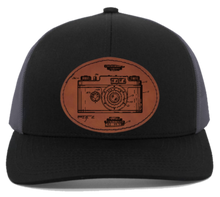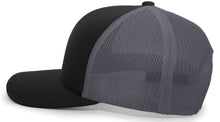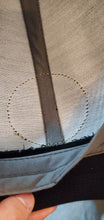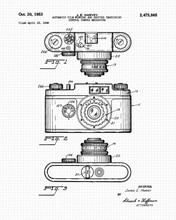Vintage Camera engraved Leather Patch hat, Industrially sewn on by hand to ensure the highest quality!
This vintage Camera is a 1953 Patent Photography Automatic Film winding and shutter tensioning.
Adjustable size- 6 3/8 (51cm) to 8 (64cm)
Custom logos or designs are always available under our design your own engraved products, Design your own leather patch hats online here, Patches are engraved and sewn on, and patch options will be round, oval, and rectangular.
"Get Inspired" with JTM VINTAGE  ®
®
History facts:
End of the 35mm Rangefinder Camera Era
The “VT” camera, introduced in August 1956, discarded the conventional film loading method, in which the film cassette was dropped into the bottom after removing the baseplate (Barnack type), and instead adopted the simpler method using a hinged back cover and threading the film onto the take-up spool. The “T” in the “VT” refers to the “trigger” because the camera incorporated the film advance mechanism with a fast-winding trigger on the camera bottom to improve the shooting speed.
The “P (Populaire)” model was released in l959, which was followed by the introduction of the “7” model in March l961 and the “7S” model in April 1965. The “7” series, which had a built-in exposure meter and were impressive in appearance, were well liked by their users. At the time, the era of the 35mm rangefinder cameras was already giving way to that of the SLR. With the interruption of the production of the “7S” in September l968, the tradition of the Canon 35mm rangefinder camera, which started with the introduction of the “Kwanon,” came to an end.
The development of the high-grade 35mm camera had been the great milestone constituting Canon’s mission. Yet during the same period, there was an effort to produce a simpler camera that could be used by anybody. That would be the development of the 35mm lens-shutter camera.It all begun in 1958 when there were heated discussions within Canon as to whether the company should take the route confined to the manufacturing of high-end cameras or whether it should also enter the market for intermediate-class cameras. Gradually, the voices of young engineers expressing the opinion “we want to make cameras we can afford” gained strength. This resulted in a tentative decision to produce a prototype of an intermediate-class camera before the company’s overall policy guidelines could be developed. With this background, the development of the 35mm lens-shutter camera started. This camera was the “Canonet,” which swept the entire camera market with the slogan “anyone can buy it and anyone can take pictures with it.”
“Canonet” display and sales counter on the 7th floor of Mitsukoshi Department Store
Although the plan was to market the “Canonet” camera in August l960, its debut was delayed until January l961 because of strong criticism from the competitors complaining that the price of under 20,000 yen was too low to compete with. When the camera was introduced for the first time at the display and sales counter on the 7th floor of Mitsukoshi department store in Nihonbashi, Tokyo, the number of people interested in seeing the camera was so great that they overflowed onto the staircases. The total inventory for one week was gone within 2 hours after the sales counter opened. Its sales were so astronomical and its customer acceptance so overwhelming that the February 6, 1961 issue of Shukan Bunshun (a popular weekly magazine) covered the sensation in the article entitled “Go To Hell!! Canonet.”
While the boom sparked by the “Canonet” had not quite cooled off yet, the “Canon Demi” camera was introduced in February 1963. It was a compact and lightweight half-frame, or single-frame, camera that permitted twice as many pictures per film. This camera was also a hit with its catch phrase “let’s draw our ‘Demi’ from our pocket.” Also released in October of the same year was the “Color Demi,” which was popular among users because it was available in three different colors: red, blue and white. With the debut of the “Demi” series, the variety of the lens-shutter cameras increased. The important thing was that the technologies acquired during the development of these 35mm lens-shutter cameras were fully fed back into the products that followed.







